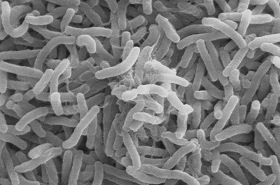Cholera, sometimes known as Asiatic or epidemic cholera, is an infectious gastroenteritis caused by enterotoxin-producing strains of the bacterium
Vibrio cholerae. Transmission to humans occurs through eating food or drinking water contaminated with
Vibrio cholerae from other cholera patients. The major reservoir for cholera was long assumed to be humans themselves, but considerable evidence exists that aquatic environments can serve as reservoirs of the bacteria.

Vibrio cholerae is a Gram-negative bacterium that produces cholera toxin, an enterotoxin, whose action on the mucosal epithelium lining of the small intestine is responsible for the disease's most salient characteristic, exhaustive diarrhea. In its most severe forms, cholera is one of the most rapidly fatal illnesses known, and a healthy person's blood pressure may drop to hypotensive levels within an hour of the onset of symptoms; infected patients may die within three hours if medical treatment is not provided. In a common scenario, the disease progresses from the first liquid stool to shock in 4 to 12 hours, with death following in 18 hours to several days, unless oral rehydration therapy is provided.
The majority of reported cholera cases worldwide occur in Africa. It is estimated that most cases of cholera are unreported due to poor surveillance systems, particularly in Africa. Fatality rates are 5% of total cases in Africa, and less than 1% elsewhere.
Source: Wikipedia.The map below is from the World Health Organization and gives a general distribution of the problem. Do not make your own assessment from this map, but rather discuss the issue with your doctor prior to travel.





